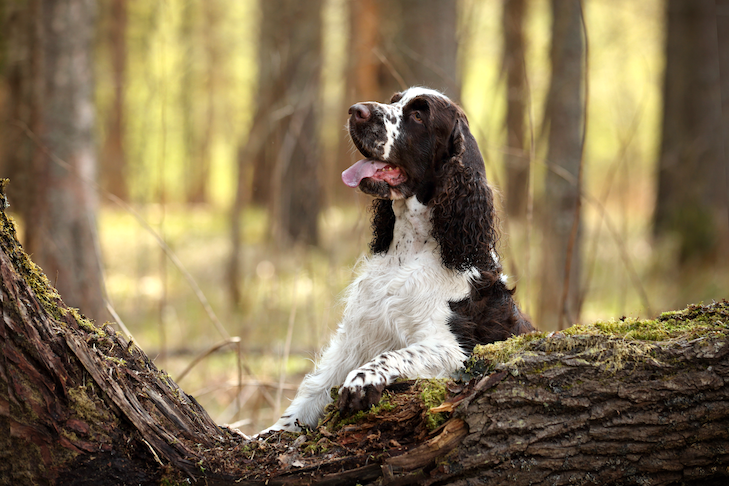Your dog goes nearly everywhere with you: from family vacations to the beach to long hikes scaling up a mountain. While dogs should be able to enjoy the outdoors, sometimes their powerful noses can lead them into nests, flocks of birds, and encounters with animals, oftentimes disrupting wildlife.
Here are some tips from wildlife experts and conservationists on how to make sure your dog respects wildlife and creates minimal disturbance to the environment.
Know Before You Go
Before heading outdoors, make sure your dog is actually allowed to be there.

“Dogs have much more access to places these days than they did 10 years ago, so I think there’s an assumption that dogs are just allowed,” says Ben Lawhon, M.S., senior director of research and consulting at the Leave No Trace Center for Outdoor Ethics.
While we want to bring our pets with us on adventures, they might not be allowed on certain trails or in national parks, an ordinance likely made to help protect the environment and your animals. Be sure to double-check before hitting the trails.
The same goes for knowing and following leash laws. For example, Beth Darrow, Ph.D., the chief scientist at the Bald Head Island Conservancy, explains that while Bald Head Island, North Carolina allows dogs on beaches, they must be leashed from sunset to sunrise during turtle season (May 1 through November 15) in order to protect nests and any sea critters that may be disturbed from a rambunctious pup.
Pick Up Their Poop
We’ve seen it one too many times: Someone made half the effort to bag up their dog’s waste, only to leave it behind when they forget to “get it on the way back.” Leaving a plastic bag behind is bad, but leaving your pet’s waste behind isn’t great for the environment either.
While you may think pet waste is natural to the environment, that’s simply not the case. Not only does dog poop smell, disturbing both guests and local wildlife, but it also is filled with supplements and other things that can be unnatural to the outdoors. Making sure you have a poop bag with you for cleanup so it won’t impact waterways, plant life, or native animals, so you can continue to enjoy these areas with your pet.
“It’s that one bad pet owner everyone remembers and we all get lumped into that crowd,” Lawhon says. “It’s up to all owners to do what we can so we can continue to get access to these lands. If we can be responsible dog owners, then we can maintain our access.”
Lawhon recommends keeping your dog close to make sure you don’t miss their No. 2 session.
![]()

Avoid Animals If Possible
It may be slightly entertaining to watch your dog chase a flock of birds on the beach, but these predator-like encounters can cause a serious stress response to native animals. According to Darrow, migrating shorebirds will use unnecessary energy to avoid dogs that could be best used for scavenging or traveling.
The best thing is to keep your dogs far away or under control.
“If you see animals behaving in a different way by you being there, then you’re having an impact on them,” Darrow says. “So just back away.”
Dogs still have a natural prey drive and they will revert to it in certain situations.
It’s especially important to consider the time of year you’re out with your dog, too. Dogs could have a big impact disturbing animals in hibernation during the winter. The same goes for mating season during the fall or springtime when many creatures are having babies.
Being conscious of these times can also help you better predict how a wild animal will react to seeing a dog. For example, a mother deer or geese may charge if something gets too close to their young.
“Having the ability to control pets and not have the harass, harm, or kill wildlife is really important,” Lawhon says. “If you’re unsure of your ability to control your dog or if you don’t have great recall, especially if there’s wildlife around, make sure your pets are leashed.”
When In Doubt Keep Them Leashed
While we all like to think we’re responsible dog owners, it’s important to note the situations when your pet may not behave their best and to leash them even when leashing isn’t required. If your dog tends to wander ahead, it’s a good idea to leash them so they don’t disturb wildlife when not under your watchful eye.
According to Lawhon, leashing is one of the easiest things we can do to minimize our cumulative impact on the environment, whether it makes you more aware of the waste your pet leaves or gives you better control when you do encounter wildlife.
It’s also good to note where your dog does behave best. Some dogs may work better in a fenced-in dog park, and that’s OK.
“I think there’s a lot of overlap between people who love dogs and people who love wildlife,” Darrow says. “People can be good beach citizens just by putting a leash on their dogs.”


